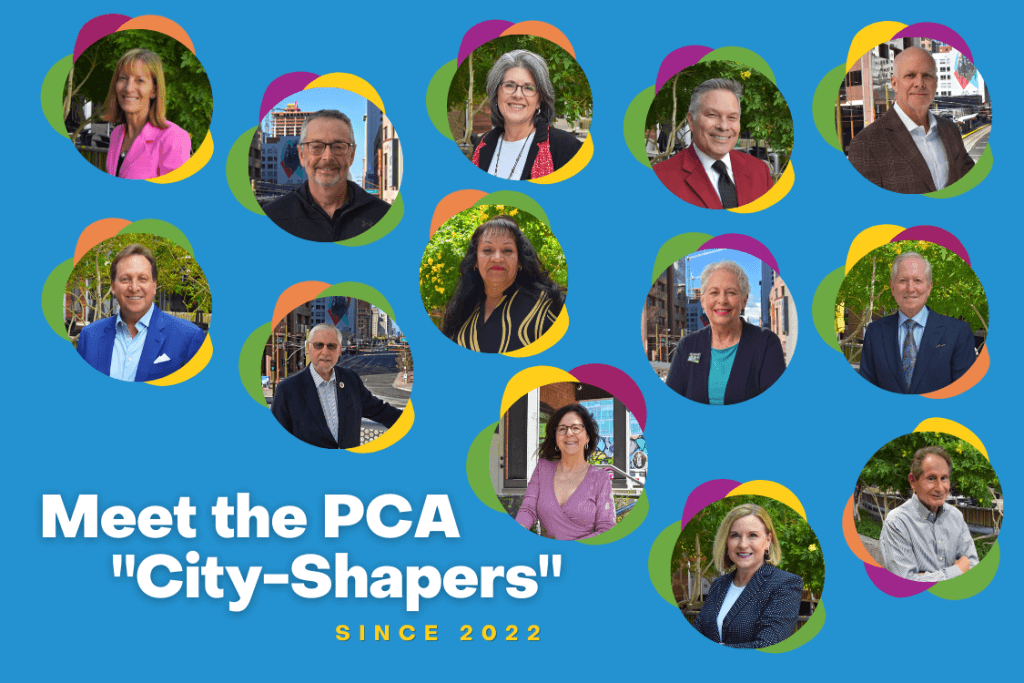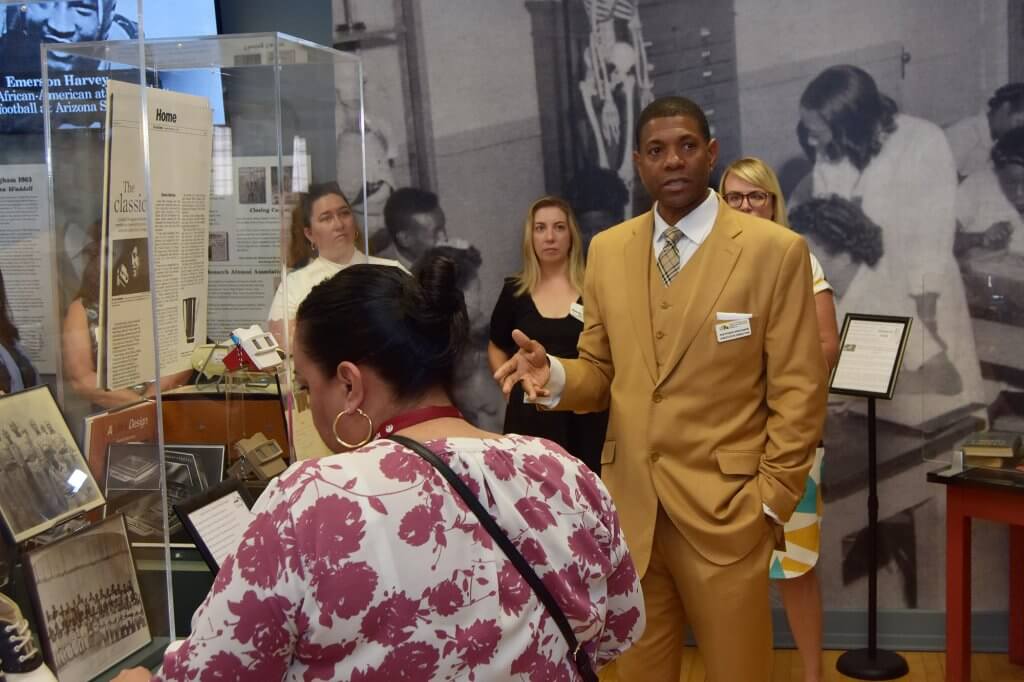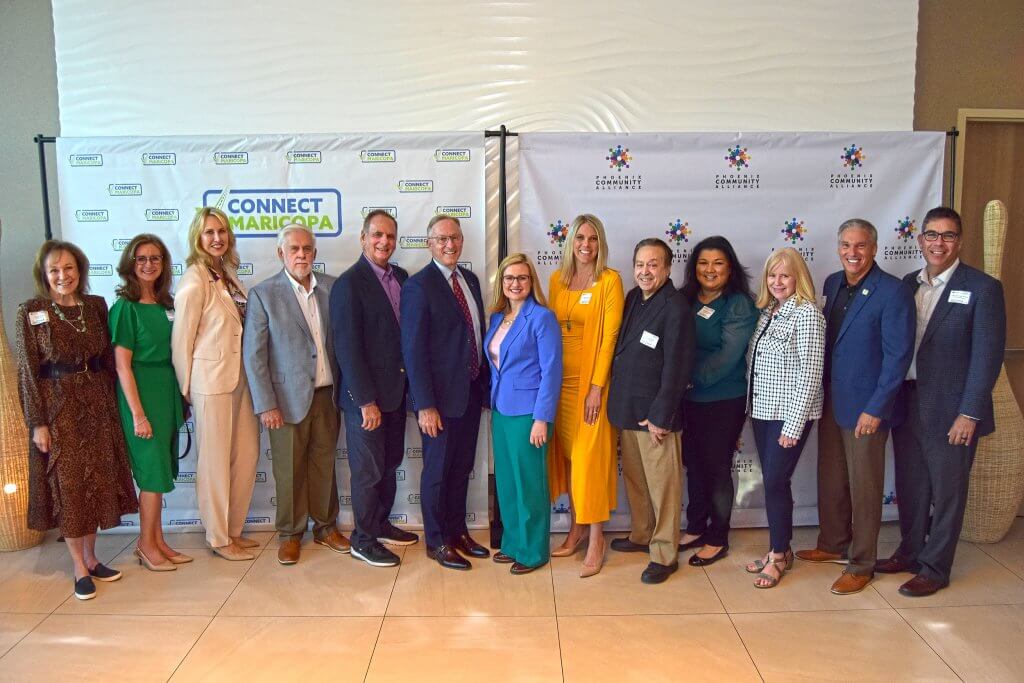For the past four decades, Phoenix Community Alliance (PCA) has sought to revitalize Greater Downtown Phoenix, which is now beginning to manifest itself.
Today, $8.3 billion in public and private investment has been infused in Downtown since 2005 (see Downtown Phoenix, Inc.’s July 2024 Facts & Figures). With approximately 1,900 business establishments, over 63,000 people working and six million visitors passing through its 1.7 square miles each year, Downtown generated $21.2 billion in economic activity in 2022 alone (Source: Rounds Consulting Group, Inc.). On the residential front, more than 12,000 residential units have been added since 2000 (6,400 since just 2018), with another 3,500 units currently under construction and nearly 2,000 planned.
But, as we wrap up our 40th Anniversary in July, it’s easy to forget: The vibrant and welcoming Downtown we know today wasn’t always this way.
Imagine the Downtown Phoenix of 1983: Urban squalor and decay. People fleeing to the suburbs. No residential density or established art and culture presence. No sports facilities to support dining and nightlife. And no rail system tying our far-flung cities together, with Downtown in the middle.
Yet, the collective interests to revitalize our core needed to be more cohesive and organized. Enter PCA.

Various Board of Directors and Executive Committee assemble at the PCA’s A Celebration of 40 Years event at One Arizona Center, pictured Thursday, October 5, 2023. (Photo by Zee Peralta)
“[Former President and Chairman of Arizona Public Service Co.] Keith Turley is the gentleman who created the concept,” said Marty Shultz, PCA’s Former Board Chair. “He realized we needed an organization and strategy to develop Downtown and created Phoenix Community Alliance.”
As other developed urban centers and downtowns invested in placemaking, PCA leadership identified the future site of Arizona Center, then the strategic heart of the city, as an ideal place to reignite Downtown as a destination. In the late 1980s, PCA helped assemble the land and sold it to Rouse Company to develop the restaurant, shopping and entertainment center, which opened in November 1990.
Last October, PCA returned to the Arizona Center for our 40th-anniversary celebration on the 11th Floor of One Arizona Center with sweeping city views and a sunset toast by our Board Chair, Diane Haller. Throughout the space, vinyl wraps by Thomas Printworks hinted at our mission statement to create a stronger Downtown for a better Phoenix.
Most organizations would be satisfied with a single legacy, but for PCA, it was the tip of the spear because of evolving leadership and advocacy.

In February 2023, a ribbon-cutting ceremony was held for the opening of the Republic Services Garden, part of a greater fundraising effort led by PCA to transform Margaret T. Hance Park, the 32.5-acre park atop the I-10 freeway tunnel, into a great Downtown park. Public-private partnerships have already resulted in Fiesta Bowl Play and, in the future, an all-day restaurant concept. (Photo by James Ritter/City of Phoenix)
Other contributions to the urban fabric of Greater Downtown Phoenix include:
- PCA’s Hance Park Fundraising Committee continues to lead a capital campaign to transform Margaret T. Hance Park, the 32.5-acre park atop the I-10 freeway tunnel, into a “great Downtown park.” Public-private partnerships have already resulted in Fiesta Bowl Play, the Republic Services Garden, and, in the future, an all-day restaurant concept as Phase One of the master plan unfolds.
- Advocating for past and future light rail development to ensure accessibility for all.
- Conceptualized a plan for sustainable growth Downtown around staples like housing, education, and transit-oriented development, which became the 2004 Downtown Strategic Plan. Community discussions initiated dialogue for stakeholders, like Downtown Voices Coalition, to form.
- Changed the trajectory of Downtown by helping to assemble land for the Phoenix Bioscience Core (PBC), a 34-acre life sciences and innovation hub encompassing all three state universities and multiple private partners.
- Orchestrated the development of Arizona Center, which is undergoing a renaissance with thoughtful local owners, Reliance Management, other investments, and the completion of PALMtower.
- Crystalizing the assembly of the state’s largest collaboration of service providers for individuals experiencing homelessness into a single campus that would become the Key Campus, formerly the Human Services Campus.
What makes PCA an effective advocacy organization? The strength and diversity of our membership roster. The leadership within pulls from different industries to triangulate what best moves our city forward. Who started an initiative isn’t as important as the consensus of its potential.
“The thing about our group is that different people have different ideas, and you don’t have to take the lead every time,” said Larry Lazarus, PCA’s Hance Park Fundraising Committee Co-Chair. “People who wait to take credit don’t get anything done. Jump on, and work on it.”
In the last two years, PCA’s staff has begun chronicling these 40 Years of Impact and the people responsible for moving Downtown forward.

Since late 2022, Phoenix Community Alliance (PCA) has begun chronicling 40 Years of Impact and the people responsible for moving Downtown Phoenix forward. As of July 22, 2024, there are 13 profiles in the series. (Photos by Taylor Costello)
Since the campaign began, we’ve spotlighted our organization’s many thought leaders, from a former Chief of Staff to multiple Phoenix Mayors, a Federal Reserve Director, a nonprofit leader, and others who defy classification.
It’s a feature of the organization that our direction comes from the collective knowledge of our Advocacy Committees and regular Member programming.
Our last Quarterly Member Meeting occurred in June in the Warehouse District, led by tours from Brian Cassidy, the Warehouse District Council’s President, and by Dr. Matthew Whittaker, George Washington Carver Museum & Cultural Center’s Executive Director. The Council was formed a decade ago this summer, just as the area’s potential came into view.
As PCA increases its geographic reach to groups around the Capitol Mall and Midtown neighborhoods, we expect these fresh perspectives to further influence our direction.

In early June, PCA held its Quarterly Member Meeting at the George Washington Carver Museum & Cultural Center, which is located in the Warehouse District. In the years to come, the area is expected to develop significantly. (Photo by Taylor Costello)
In the fall, the Phoenix City Council votes on an update of the Downtown Code chapter within Phoenix Zoning Ordinances, on which multiple working groups collaborated with City of Phoenix Planning & Development Department staff to refine. More than a simple line-item revision, the revisions throughout the document are updates to refine or evolve the standards and values of our pedestrian-oriented, dynamic urban center. All advocacy efforts within PCA’s Committee structure are similarly granular efforts, such as:
- Arts, Culture & Public Life Committee (ACPL) – Forming a working group that utilizes our Arts & Culture Committee Members to curate the best Downtown guest experience for visitors, such as sharing information about activities, navigation, and parking options.
- Social & Housing Advancement Committee (SHA) – Through the City of Phoenix’s annual budget process, advocating for the Housing Department’s need for additional full-time staff to manage new residential development projects and the preservation of existing units
- Multi-Modal Connectivity Committee – Connecting with other advocacy organizations supporting Prop 479, a continuation of a half-cent sales tax funding public transportation through 2050, to support the November ballot campaign and advocate for the reliable and accessible transportation that the light rail system provides to the community.
A return on engagement has always been the secret sauce to our continued vibrancy: During any given week, hundreds of active Members are dedicating their time and expertise to PCA, strengthening the collective voice of the diverse membership.
That engagement is alluded to with our logo, designed by LaneTerralever in 2017, which invokes individuals connecting at a table.
With more than 340 Members (and growing each week), the advocacy of the next 40 years will be different from our first four decades.
And we welcome you to join our young organization to help write that next chapter.

Ten Arizona mayors flocked to Downtown Phoenix to support Phoenix Community Alliance’s (PCA) fundraiser to benefit Prop 479, the continuation of a half-cent sales tax funding public transportation through 2050, pictured Tuesday, May 21, 2024. (Photo by Taylor Costello)






